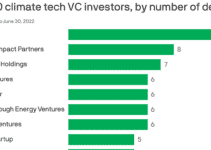It’s often said that, as humans, we’re wired to seek out novelty. To search for the next big thing. In the drive to decarbonization, I’d argue that many companies are no different. Today, scores of global brands are trialing novel technologies.
Take luxury goods group Kering, for instance, working with California-based VitroLabs Inc. to develop cow-free, lab-grown leather. Or cosmetics giant L’Oreal, working with French biotech Carbios to create bottles from enzymatically recycled plastic.
Please be under no illusion: I believe it’s incredibly important that companies pilot such technologies. But it must be acknowledged that doing so is, by its very nature, risky; if the startup cannot develop its (complex) tech at an investor-friendly pace, it may struggle to raise its next investment round and the pilot may come to nothing.
While making big bets on future solutions, companies must also ensure they’re taking full advantage of the technologies available today. Many are software-based and seek to enable the adoption and optimization of lower-risk, tried and tested solutions.
Take converting your fleet from internal combustion engine to electric, for instance. A McKinsey report, released in December, confirms it’s a need and that “fleet operators are under pressure to transition to greener business models.”
Danish EV charging startup Monta is helping businesses do just that. Casper Rasmussen, CEO, notes that many are “looking for a software solution that can support their employees,” although “very few companies do this.” Monta was founded in 2020. A key benefit of its software is that it makes life as easy as possible for company car drivers. Its all-in-one app allows them to easily reserve charge times, charge at “310,000 charge points in Europe” and be reimbursed for home charging. It currently counts a number of “well-known global companies,” such as wind turbine giant Vestas, Nordic postal service PostNord, and Copenhagen Airport as clients.
Today, software can also be used to help maximize the carbon sequestered by any forest a company owns — trees are, after all, well known carbon sinks. Currently working closely with Germany’s “largest forestry enterprises,” OCELL uses aerial imaging and AI to suggest ways to improve forest growth. Forest management plans can then be adapted accordingly.
The good news is that the development of such enabling software is unlikely to stop anytime soon. Rob Stoecker is an impact investor at AENU, a Berlin-based venture capital firm that has invested in both Monta and OCELL. He said that, over the last 10 to 15 years, B2B SaaS has been “on the wishlist of every venture capital firm,” thanks to nice margins, limited marginal cost and the ability to easily scale internationally. Although the wider funding environment is “horrible,” he’s bullish on investment in climate tech as “everyone just knows we cannot wait until another recession is over.”
Companies also don’t need to wait for relevant, startup-built software to come to market. Matt Jonns is the founder of Founder and Lightning, a B2B SaaS venture builder, with offices in London, Cardiff, Kraków and India. Interestingly, he predicts that some large companies will soon “start to hire internal no-code builders and AI prompters,” to solve specific problems in-house.
The power of artificial intelligence software should not be overlooked. In a report released in 2021, consulting firm Capgemini explored “over 70 AI-enabled use cases for climate action.” It found a number of interesting examples, including General Motors using generative design to build a new, 40 percent lighter seat belt bracket that requires fewer resources, and Rio Tinto increasing the serviceable life of its 900 dump trucks with machine learning.
The point is, regardless of how they do so, companies should always be asking themselves one simple question: are we using software to take full advantage of the solutions available today?


